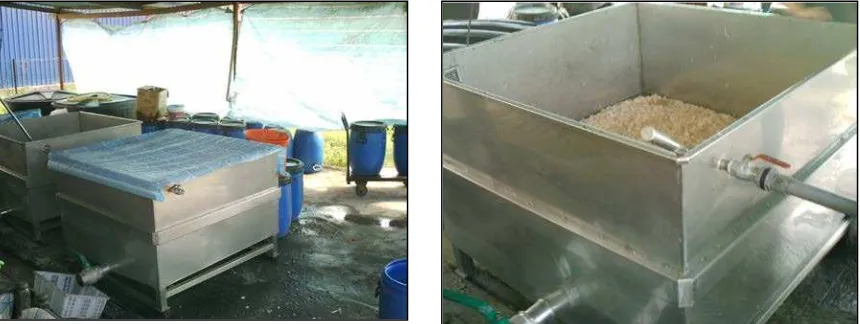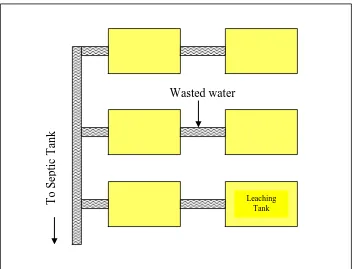SALEHUDDIN BIN TALIB
Laporan ini diserahkan kepada Fakulti Kejuruteraan Mekanikal sebagai memenuhi sebahagian daripada syarat penganugerahan Ijazah Sarjana Muda Kejuruteraan
Mekanikal (Rekabentuk & Inovasi)
Fakulti Kejuruteraan Mekanikal Universiti Teknikal Malaysia Melaka
"I hereby verify that I have read this project report and in my opinion, this report is acceptable within the scopes and quality for graduation."
Signature : ...
Supervisor Name : EN. NAZIM BIN ABD. RAHMAN
"I hereby certify that this project report is on my own work except for any diagrams, figures and reports that I have used and taken from other sources have been verified on
each of them."
ACKNOWLEDGEMENTS
Firstly, I am forever grateful to God for giving me guidance and strength to finish this project as scheduled. A thousand thanks to Universiti Teknikal Malaysia Melaka for giving me the opportunity to conduct this bachelor of degree project, specifically in doing the research in nata de’ coco industry.
I would also like to convey my gratitude my supervisor of this project, Mr. Mohd. Nazim bin Abd. Rahman for his cooperation and guidance during. Thanks to Mrs. Norasra for helping me in chemical theories and concepts learning; Mr. Mohd. Haizal bin Mohd. Husin for helping me in conducting the leaching experiment. Thanks to Mr. Safaruddin bin Ghazali and Mr. Tee Boo Tuan for their guidance about the fluid mechanics, activated carbon usage and technology. Not, forgetting Mr. Nor Zaini bin Abd. Rahman, the manager of Anzag Industries (M) Sdn. Bhd., his secretary and other staffs for giving me their informations and views about facts and process involved in the nata industry.
THE DESIGN OF WATER FLOW SYSTEM FOR LEACHING PROCESS
ABSTRACT
REKABENTUK SISTEM ALIRAN AIR UNTUK PROSES PENAPISAN AIR
ABSTRAK
LIST OF CONTENS
TITLE PAGES
ACKNOWLEDGEMENT i
ABSTRACT ii
ABSTRACT (Malay) iii
CHAPTER 1 INTRODUCTION / OVERVIEW 1
1.1 Problem Statement 2
1.2 Objective of Study
1.3 Scopes 3
CHAPTER 2 LITERATURE
2.1 About Nata de’ Coco
2.1.1 Definition 4
2.1.2 History 5
2.2 Existing System Design Study 5
2.3 Process Flow 7
2.4 Leaching Process 9
2.4.1 Leaching Theory 10
2.5 Bacterial cellulose 11
2.6 Alternative Concepts - Activated Carbon 9 2.6.1 Activated Carbon – Processes 18 2.7 Alternative Concepts – Ozone 25
2.9 Theory 27
3.0 METHODOLOGY 29
3.1 Design Flow Process 29
3.2 Formulating Process 31
3.3 Concept Study 33
3.3.1 Clarify Function 34
3.3.2 Generate Alternative concepts 35
3.3.3 Analyzing alternative concepts 35
3.3.4 Best Concept 35
4.0 DESIGN DEVELOPMENT 36
4.1 Formulating 36
4.2 Generate Alternative concepts 37
4.3 Analyzing alternative concepts 38
4.4 Evaluation alternative concepts 43
4.5 Best Concept 45
5.0 RESULTS AND DISCUSSION 46
5.1 Approaching to ozone process 48
5.2 Result of experiments 55
5.2.1 Water Circulation Design for Leaching Process 58
5.3 Pump Selection 61
5.4 Water flow Diagram 63
5.5 Programmable Logical Controller (PLC) 64
5.6 System Flow Chart 65
5.7 Water Circulation Design System 66
CONCLUSION 78
RECOMMENDATIONS 80
APPENDIXES
LIST OF TABLES
NO TABLE PAGES
2.1 Activated carbon can absorb acetic acid 18 4.1 Engineering Design Specification 36 4.2 Pugh’s method weighted rating for 44
leaching concepts
LIST OF FIGURES
NO FIGURE PAGES
2.1 Nata de’ Coco product 4
2.2 Location of leaching tanks 6
2.3 Tank fills with nata de’coco 6
2.4 The existing system of leaching process 7
2.5 Process flow chart 8 2.6 A stick for stirring nata 9 2.7 The products in the water 9 2.8 SEM micrography 11
2.9 The formation of ozone 26
3.1 Block diagram of design process 29
3.2 PSM I and PSM II Design Flow Chart 30
3.3 Formulating Design problem 32
3.4 Concept design decision-making activities 33
3.5 Function decomposition diagram of a 34
leaching machine 4.1 Recent leaching system diagram 38
4.2 Recent system 38
4.3 Alternative System 39
4.4 First condition of system 39
4.5 Second condition of system 40
4.6 Activated carbon water flow system 40
4.7 The system of water flow 41
4.8 Water treatment system by using activated carbon 41
4.9 A system used an ozone concept 42
5.1 Pointer of Hydrogen graph 56
and ozone approach.
5.3 Percentage of Acetic Acid Between conventional 57
and ozone approach. 5.4 Design Water Circulation System 59-61 5.5 New Design of System 62
5.6 Pump Catalogue 63
5.7 A set of selected pump 63
5.8 Water flow Diagram 64
5.9 AC input 65
5.10 Photocouplers 65
5.11 System Flow Chart 66
5.12 A New Leaching System Design 67
5.13 Lower limit level sensor 68
5.14 Upper Limit Level Sensor 68
5.15 Timer ladder diagram 69
5.16 Counter ladder diagram 70
5.17 Tank Diagram 71
5.18 A subsystem ladder diagram 71
5.19 Mechanism with PLC system 74
5.20 Complete System Diagram 78
5.21 Pressure Analysis 80
NOTATIONS
WORD DEFINITION UNITS
Area The area of flow diameter cm3/m3 Length The length of flow from begin to end cm/m
pH pointer of Hydrogen number
Time second/minute/hour s/min/hour
Volume Contains per metric m3
X Power of zooming under microscope number
AC Activated Carbon --
Q Flow Rate L/min
M Concentration of acid (Molar) mol/kg
V Volume ml
m mass kg/g
A area of surface / offset m2
t times second
SYMBOLS
SYMBOLS DEFINITION
Air Dryer Air Receiver Electric Motor
Flow Indicator Filter
Pump
Gas
Drain Water
CHAPTER I
INTRODUCTION / OVERVIEW
Leaching generally known as a process to dissolves any unwanted elements in a solution. It is also comes in different kinds and shapes. Leaching process can be in fluid, gas or solid form of matter. Normally, this kind of process has been applied in water treatment industry. Nata de’ coco industry applying the leaching process for nata neutralization. After fermentation of nata, the value of pointer Hydrogen (pH) in nata is 3.0 which not consumption. It has a bad smell because it is contains of acetic acid. Leaching process is using to can remove the smell or acetic acid molecules. So it must be neutralizing up to pH 7.0 by using water as the medium for neutralization with a long period. The water needs to be replaced regularly during the leaching process.
This project shows about water flow system and the mechanism. Also configures the best concept in the process according to characteristic of concept. The process starts from putting the acidic nata into a tank until it existed. Also include a part design and function of mechanism.
The results from this project can be use to develop a new machine with a new concept or method as upgrade to existing process of leaching nata de’ coco. So it may be use for an alternative ways in production. The concept that has been selected is one of the several concepts that possibly can use as an alternative. The selected concept also has considered about many factors that has an effective results while running production.
By overall, the project is going to making an improvement of the manual process in manufacturing into an automatic process that using machine technology.
1.1 Problem Statement
The production of nata de’ coco increased towards to business expands. Several factors like low price, effectiveness, economical have a big potential to be selected. Without any improvement, nata productivity cannot be increase. The production must be more efficiency, faster, low cost, and capable to produce products in a short time.
1.2 Objective of Study
The objective of this project is to design a water circulation system for leaching and its mechanism.
1.3 Scopes
The scopes that need to study are: 1) To study leaching process.
2) To design water treatment and the circulation system.
CHAPTER II LITERATURE REVIEW
2.1 About Nata de’ Coco
2.1.1 Definition:
[image:21.612.246.450.509.672.2]Nata de coco is a chewy, translucent, traditional Philippine dessert which is “coconut gel-product” from coconut water by bacterial fermentation-prepared. Produced by Acetobacter aceti ssp. xylinum through fermentation of fruit juices. Nata de coco is high in fiber, good for the digestive system, and it is low calories and contains no cholesterol. [1].
2.1.2 History:
The growth of nata de’ coco in the early 90s had multiply effects in job and business opportunities in allied industries such as plastic container manufacturing and supply chain, coconut and sugar industries, glacial acetic acid production, and packaging materials.
Producers and processors expressed their need to be informed of recent breakthroughs in nata de’ coco processing, current market trends and related issues. The industry proved Philippines to become the largest quality producer of nata de’ coco and achieve pioneering leadership in the fields of food and industrial application.
In 1993, Japanese people, especially young people considered nata de’ coco a popular dessert, however, the popularity decreased because customers like another trendy dessert. For small farmers or else started coconut production in Philippine have begun to export nata de’ coco to Japan. Japan imported 90 percent of the Philippines nata de’ coco, its supply did not meet the demand for the dessert in Japan. One year later, the product popularity quieted. Environmental and unemployment problems caused to Japan was importing nata de’ coco from Philippines [1].
2.2 Existing System Design Study
Recently, in local industry, leaching process in nata production was operating with manual process (Fig.2.2, 2.3). After fermentation, nata could be in very acidic because it is containing acetic acid. Normally, the value of pointer Hydrogen (pH) after fermentation is about 2.2 up to 3.0. In neutralizing or can be considered as leaching process, it is using plenty of water to neutralizing nata. The acidic nata must be immersed in water about six to seven hours. So, water must be replaced nearly in every one hour.
[image:23.612.117.547.508.670.2]They used a rubber pipe to flow water, filling six leaching tanks. Then the leaching tanks were drained, using other pipes direct into a septic tank (Fig.2.4). For details, water must be renewing every an hour (normally) until the pH value reach up to 7.0. So that, the leaching process needs about six to seven times to be completed. After the last drain, leaching process is finish and nata can be carrying out to be cooked. If the volume of each leaching tank is 1 meter3, the whole leaching process requires up to 7 meter3 of water. During leaching process, it must be stirring up twice an hour using a stainless steel stick as a tool. Nata need to be stirred to reduce leaching process period.
Figure 2.2: The wasted water drained through Figure 2.3: Tank filled with nata de’
Figure 2.4: The existing system of leaching process.
2.3 Process Flow
The chart below showns about the whole process in nata production (fig 2.5). From this chart, we can see that leaching process is situated between slicing and cooking process. All the process must consider for standard and safety to avoid give any negative affects to other process even after any improvement activities in leaching process.
If any modification can give a negative effect to other process, standardize or setting in the process must be changed. Every improvement in leaching cycle must consider every aspect of nature and chemical reaction.
Wasted water
T
o
S
ep
ti
c T
an
k
![Figure 2.1: Nata de’ Coco product [1]](https://thumb-ap.123doks.com/thumbv2/123dok/681415.84165/21.612.246.450.509.672/figure-nata-de-coco-product.webp)

